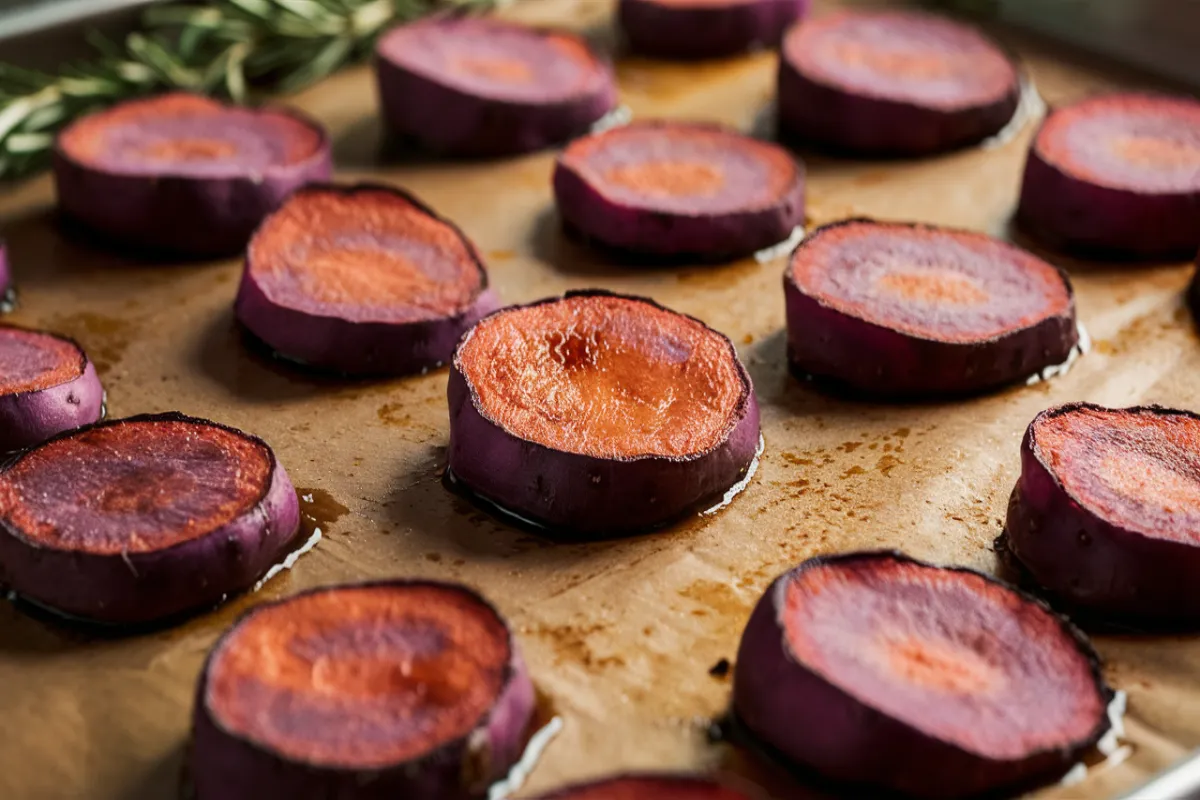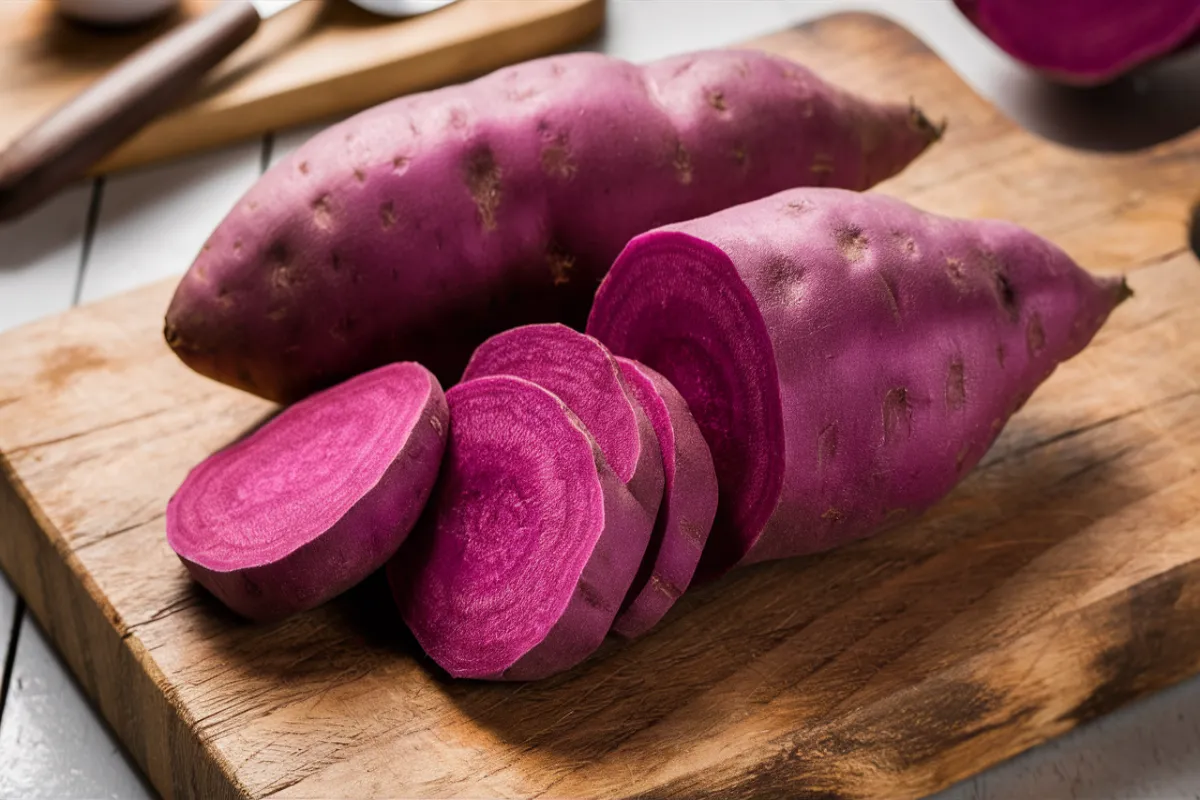Purple sweet potatoes stand out for their vibrant color, but their taste is what truly intrigues many people. You might wonder whether they taste different from the more common orange variety. The answer is yes, but the differences are subtle and nuanced. In this article, I will explore what sets purple sweet potatoes apart, from their flavor to their culinary uses. By the end, you’ll understand exactly how purple sweet potatoes differ in taste and how to make the most of their unique qualities in your cooking.
1. What Makes Purple Sweet Potatoes Unique?
1.1 Visual Appeal and First Impressions
The first thing you notice about purple sweet potatoes is their striking color. Their deep purple flesh immediately sets them apart from the familiar orange varieties. This vibrant hue doesn’t just add visual appeal but also hints at differences in flavor and texture. However, it’s important to consider how this visual difference might influence your expectations before diving into the taste.
1.2 Understanding the Flavor Profile
When you first taste a purple sweet potato, you might find the flavor surprisingly mild. Purple sweet potatoes have a slightly earthier taste compared to the sweetness of orange varieties. Their flavor can be described as subtly nutty, with a hint of floral notes. However, unlike orange sweet potatoes, which are often moist and sugary, purple sweet potatoes offer a more subdued sweetness that pairs well with both sweet and savory dishes.
1.3 Comparing Purple and Orange Sweet Potatoes
Comparing purple sweet potatoes to orange ones reveals a few key differences. Orange sweet potatoes are often chosen for their sugary taste and moist texture, making them ideal for desserts and sweet casseroles. In contrast, purple sweet potatoes bring a unique earthiness and firmer texture, which can make them more versatile in savory dishes. Despite these differences, both types of sweet potatoes can be used interchangeably in many recipes, depending on the flavor profile you want to achieve.
2. The Texture of Purple Sweet Potatoes

2.1 Firmer and Denser Texture
Purple sweet potatoes have a firmer and denser texture compared to orange varieties. This characteristic makes them ideal for dishes where you want the potatoes to hold their shape. For instance, when roasting or grilling, purple sweet potatoes maintain their structure better than their orange counterparts. Their denser texture also means they take slightly longer to cook, so adjustments to cooking times are necessary.
2.2 Impact on Culinary Uses
The firmer texture of purple sweet potatoes makes them particularly well-suited for savory dishes. They work beautifully in recipes that require the potatoes to maintain their shape, such as in gratins or salads. However, their denser consistency might not be ideal for dishes that rely on a smooth, creamy texture, such as mashed potatoes or certain types of pies. Understanding how the texture affects the final dish is crucial for achieving the desired outcome in your recipes.
2.3 Tips for Perfectly Cooking Purple Sweet Potatoes
To get the best results when cooking purple sweet potatoes, consider adjusting your methods slightly. For instance, steaming or boiling purple sweet potatoes can help soften their firm texture, making them easier to mash or puree. Additionally, slicing them thinly before baking or roasting can help them cook more evenly. Always remember to check for doneness by piercing the potatoes with a fork; they should feel tender but still firm.
3. Flavor Differences: Subtle Yet Distinct
3.1 Earthy and Nutty Notes
Purple sweet potatoes offer a flavor profile that’s earthy and subtly nutty. Unlike the pronounced sweetness of orange sweet potatoes, the flavor of purple sweet potatoes leans more towards the savory side. This earthiness makes them a perfect match for herbs and spices like rosemary, thyme, and garlic. The nutty undertone also pairs well with nuts, seeds, and other ingredients that complement this flavor.
3.2 Balancing Sweetness and Earthiness
The subtle sweetness of purple sweet potatoes makes them versatile in both sweet and savory dishes. In sweet recipes, the earthiness balances out sugar and spice, preventing the dish from becoming overly sweet. Conversely, in savory dishes, this sweetness adds a delicate contrast to stronger, more robust flavors. Understanding how to balance these elements allows you to create dishes that highlight the unique taste of purple sweet potatoes.
3.3 How Cooking Methods Affect Flavor
Cooking methods can significantly influence the flavor of purple sweet potatoes. Roasting enhances their natural sweetness and brings out their nutty undertones, while boiling or steaming can mute these flavors slightly. Grilling adds a smoky depth, complementing the earthiness of the potatoes. Experimenting with different cooking techniques helps you discover the full range of flavors that purple sweet potatoes can offer.
4. Culinary Applications of Purple Sweet Potatoes

4.1 Ideal Dishes for Purple Sweet Potatoes
Purple sweet potatoes shine in a variety of dishes, especially those that benefit from their firm texture and earthy flavor. They’re perfect for roasting, where their natural sweetness is enhanced, and they develop a slightly crispy exterior. Additionally, they work well in savory pies, casseroles, and salads, where their unique color and taste add a special touch. They can also be used in soups, where their dense texture holds up well in broths and stews.
4.2 Pairing with Other Ingredients
Pairing purple sweet potatoes with the right ingredients enhances their flavor and creates balanced dishes. For savory recipes, consider combining them with ingredients like garlic, rosemary, thyme, and olive oil. Their earthy flavor also pairs well with meats like pork and lamb. For a sweet twist, pair them with cinnamon, nutmeg, and maple syrup. The key is to choose ingredients that complement the natural flavors of the purple sweet potato without overpowering them.
4.3 Creative Uses in Desserts
Although purple sweet potatoes are often used in savory dishes, they can also be a fantastic addition to desserts. Their mild sweetness and unique color make them ideal for cakes, pies, and even ice cream. When using them in desserts, balance their earthiness with sweet spices and ingredients like vanilla, honey, or brown sugar. Their vibrant color also adds a visual appeal to any dessert, making them as pleasing to the eye as they are to the palate.
Learn surprising ways to boost your creativity every day
5. How to Maximize the Flavor of Purple Sweet Potatoes
5.1 Enhancing Flavor Through Seasoning
Seasoning is key to bringing out the best in purple sweet potatoes. Simple seasonings like salt, pepper, and olive oil can enhance their natural flavors without overpowering them. For a more complex flavor profile, try adding spices like cumin, coriander, or smoked paprika. These spices complement the earthy notes of the purple sweet potatoes and add depth to your dishes.
5.2 Marinating for Deeper Flavor
Marinating purple sweet potatoes before cooking can infuse them with additional flavors. A simple marinade of olive oil, garlic, and herbs works well for savory dishes. For a sweeter preparation, consider marinating them in a mixture of honey, cinnamon, and citrus juice. Marinating not only enhances the flavor but also helps to soften the potatoes, making them more tender and flavorful.
5.3 Using Cooking Techniques to Intensify Taste
Different cooking techniques can intensify the flavor of purple sweet potatoes. Roasting, for example, caramelizes the natural sugars in the potatoes, bringing out their sweetness and adding a slight crispness to the edges. Grilling imparts a smoky flavor that complements their earthiness. Steaming, while a gentler method, allows the natural taste of the purple sweet potatoes to shine through without adding any additional flavors. Each technique offers a different way to enjoy the unique taste of purple sweet potatoes.
6. Frequently Asked Questions About Purple Sweet Potatoes
6.1 Do Purple Sweet Potatoes Taste Sweeter Than Orange Ones?
No, purple sweet potatoes do not taste sweeter than orange varieties. They have a milder, more earthy flavor with subtle nutty notes. Orange sweet potatoes are generally sweeter and have a moister texture, making them ideal for desserts and sweet dishes. However, purple sweet potatoes’ subdued sweetness allows them to work well in both sweet and savory recipes.
6.2 Can Purple Sweet Potatoes Be Used in Place of Orange Sweet Potatoes?
Yes, you can use purple sweet potatoes in place of orange ones in most recipes. However, be aware that the flavor and texture will differ. Purple sweet potatoes are firmer and less sweet, so they may not work as well in dishes that rely on the sweetness and creaminess of orange sweet potatoes. They are better suited for savory dishes or recipes where their unique flavor and color can shine.
6.3 How Do Purple Sweet Potatoes Compare to Regular Potatoes?
Purple sweet potatoes are sweeter and more flavorful than regular potatoes. They have a firmer texture and a richer, earthier taste. Unlike regular potatoes, which are often used as a neutral base in many dishes, purple sweet potatoes bring their own distinctive flavor to recipes. They are particularly well-suited for dishes that benefit from their sweetness and firm texture, such as roasted vegetables, gratins, and salads.
6.4 Are There Different Varieties of Purple Sweet Potatoes?
Yes, there are several varieties of purple sweet potatoes, each with slightly different flavors and textures. Some common varieties include Okinawan, Stokes, and Murasaki sweet potatoes. Okinawan sweet potatoes have a creamy texture and a mildly sweet flavor, while Stokes sweet potatoes are firmer and more earthy. Murasaki sweet potatoes are known for their deep purple skin and sweet, nutty flavor. Each variety offers a unique taste experience, so it’s worth trying different types to see which you prefer.
6.5 How Should Purple Sweet Potatoes Be Stored?
Store purple sweet potatoes in a cool, dark place with good ventilation, such as a pantry or a cellar. Avoid storing them in the refrigerator, as this can cause the potatoes to develop a hard core and alter their texture. When stored properly, purple sweet potatoes can last for several weeks. Check them regularly for signs of sprouting or soft spots, and use them promptly if you notice any changes in texture.
Conclusion: Discover the Unique Taste of Purple Sweet Potatoes
Purple sweet potatoes offer a unique flavor profile that sets them apart from other varieties. Their subtle earthiness, mild sweetness, and firmer texture make them a versatile ingredient in both sweet and savory dishes. Whether you’re roasting them to bring out their natural sweetness or incorporating them into creative desserts, purple sweet potatoes add a distinctive taste and vibrant color to your culinary creations. By understanding how they differ from other types of sweet potatoes, you can make the most of their unique qualities in your cooking. Enjoy experimenting with this versatile ingredient and discovering all the delicious possibilities it has to offer.

